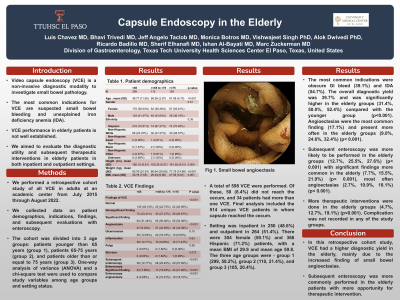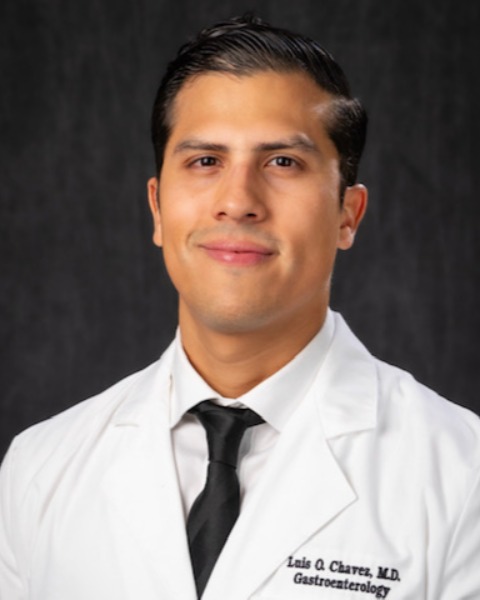Tuesday Poster Session
Category: Small Intestine
P4114 - Video Capsule Endoscopy in the Elderly
Tuesday, October 24, 2023
10:30 AM - 4:00 PM PT
Location: Exhibit Hall

Has Audio

Luis Chavez, MD
Texas Tech University Health Sciences Center
El Paso, TX
Presenting Author(s)
Award: Outstanding Research Award in the Small Intestine Category (Trainee)
Award: Presidential Poster Award
Luis Chavez, MD, Bhavi Trivedi, MD, Jeff Angelo Taclob, MD, Sherif E. Elhanafi, MD, Monica Botros, MD, Ishan Al-Bayati, MD, Ricardo Badillo, MD, Vishwajeet Singh, PhD, Alok Dwivedi, PhD, Marc Zuckerman, MD
Texas Tech University Health Sciences Center, El Paso, TX
Introduction: Video capsule endoscopy (VCE) is a non-invasive diagnostic modality to investigate small bowel pathology. The most common indications for VCE are suspected small bowel bleeding and unexplained iron deficiency anemia (IDA). VCE performance in elderly patients is not well established. We aimed to evaluate the diagnostic utility and subsequent therapeutic interventions in elderly patients in both inpatient and outpatient settings.
Methods: We performed a retrospective cohort study of all VCE in adults at an academic center from July 2015 through August 2022. We collected data on patient demographics, indications, findings, and subsequent evaluations with enteroscopy. The cohort was divided into 3 age groups: patients younger than 65 years (group 1), patients 65-75 years (group 2), and patients older than or equal to 75 years (group 3). One-way analysis of variance (ANOVA) and a chi-square test were used to compare study variables among age groups.
Results: A total of 598 VCE were performed. Of these, 50 (8.4%) did not reach the cecum, and 34 patients had more than one VCE. Final analysis included the 514 unique VCE patients in whom capsule reached the cecum. Setting was inpatient in 250 (48.6%) and outpatient in 264 (51.4%). There were 304 female (59.1%) and 366 Hispanic (71.2%) patients, with a mean BMI of 29.9 and mean age 59.8. The three age groups were - group 1 (299, 58.2%), group 2 (110, 21.4%), and group 3 (105, 20.4%). The most common indications were obscure GI bleed (39.1%) and IDA (54.7%). The overall diagnostic yield was 39.7% and was significantly higher in the elderly groups (31.4%, 50.0%, 52.4%) compared with the younger group (p< 0.001). Angioectasias were the most common finding (17.1%) and present more often in the elderly groups (9.0%, 24.6%, 32.4%) (p< 0.001). Subsequent enteroscopy was more likely to be performed in the elderly groups (12.7%, 25.5%, 27.6%) (p< 0.001) with significant findings more common in the elderly (7.7%, 15.5%, 21.9%) (p< 0.001), most often angioectasias (2.7%, 10.9%, 18.1%) (p< 0.001). More therapeutic interventions were done in the elderly groups (4.7%, 12.7%, 19.1%) (p< 0.001). Complications were not recorded in any of the study groups.
Discussion: In this retrospective cohort study, VCE had a higher diagnostic yield in the elderly, mainly due to the increased finding of small bowel angioectasias. Subsequent enteroscopy was more commonly performed in the elderly patients with more opportunity for therapeutic intervention.
Disclosures:
Luis Chavez, MD, Bhavi Trivedi, MD, Jeff Angelo Taclob, MD, Sherif E. Elhanafi, MD, Monica Botros, MD, Ishan Al-Bayati, MD, Ricardo Badillo, MD, Vishwajeet Singh, PhD, Alok Dwivedi, PhD, Marc Zuckerman, MD. P4114 - Video Capsule Endoscopy in the Elderly, ACG 2023 Annual Scientific Meeting Abstracts. Vancouver, BC, Canada: American College of Gastroenterology.
Award: Presidential Poster Award
Luis Chavez, MD, Bhavi Trivedi, MD, Jeff Angelo Taclob, MD, Sherif E. Elhanafi, MD, Monica Botros, MD, Ishan Al-Bayati, MD, Ricardo Badillo, MD, Vishwajeet Singh, PhD, Alok Dwivedi, PhD, Marc Zuckerman, MD
Texas Tech University Health Sciences Center, El Paso, TX
Introduction: Video capsule endoscopy (VCE) is a non-invasive diagnostic modality to investigate small bowel pathology. The most common indications for VCE are suspected small bowel bleeding and unexplained iron deficiency anemia (IDA). VCE performance in elderly patients is not well established. We aimed to evaluate the diagnostic utility and subsequent therapeutic interventions in elderly patients in both inpatient and outpatient settings.
Methods: We performed a retrospective cohort study of all VCE in adults at an academic center from July 2015 through August 2022. We collected data on patient demographics, indications, findings, and subsequent evaluations with enteroscopy. The cohort was divided into 3 age groups: patients younger than 65 years (group 1), patients 65-75 years (group 2), and patients older than or equal to 75 years (group 3). One-way analysis of variance (ANOVA) and a chi-square test were used to compare study variables among age groups.
Results: A total of 598 VCE were performed. Of these, 50 (8.4%) did not reach the cecum, and 34 patients had more than one VCE. Final analysis included the 514 unique VCE patients in whom capsule reached the cecum. Setting was inpatient in 250 (48.6%) and outpatient in 264 (51.4%). There were 304 female (59.1%) and 366 Hispanic (71.2%) patients, with a mean BMI of 29.9 and mean age 59.8. The three age groups were - group 1 (299, 58.2%), group 2 (110, 21.4%), and group 3 (105, 20.4%). The most common indications were obscure GI bleed (39.1%) and IDA (54.7%). The overall diagnostic yield was 39.7% and was significantly higher in the elderly groups (31.4%, 50.0%, 52.4%) compared with the younger group (p< 0.001). Angioectasias were the most common finding (17.1%) and present more often in the elderly groups (9.0%, 24.6%, 32.4%) (p< 0.001). Subsequent enteroscopy was more likely to be performed in the elderly groups (12.7%, 25.5%, 27.6%) (p< 0.001) with significant findings more common in the elderly (7.7%, 15.5%, 21.9%) (p< 0.001), most often angioectasias (2.7%, 10.9%, 18.1%) (p< 0.001). More therapeutic interventions were done in the elderly groups (4.7%, 12.7%, 19.1%) (p< 0.001). Complications were not recorded in any of the study groups.
Discussion: In this retrospective cohort study, VCE had a higher diagnostic yield in the elderly, mainly due to the increased finding of small bowel angioectasias. Subsequent enteroscopy was more commonly performed in the elderly patients with more opportunity for therapeutic intervention.
Disclosures:
Luis Chavez indicated no relevant financial relationships.
Bhavi Trivedi indicated no relevant financial relationships.
Jeff Angelo Taclob indicated no relevant financial relationships.
Sherif Elhanafi indicated no relevant financial relationships.
Monica Botros indicated no relevant financial relationships.
Ishan Al-Bayati indicated no relevant financial relationships.
Ricardo Badillo indicated no relevant financial relationships.
Vishwajeet Singh indicated no relevant financial relationships.
Alok Dwivedi indicated no relevant financial relationships.
Marc Zuckerman indicated no relevant financial relationships.
Luis Chavez, MD, Bhavi Trivedi, MD, Jeff Angelo Taclob, MD, Sherif E. Elhanafi, MD, Monica Botros, MD, Ishan Al-Bayati, MD, Ricardo Badillo, MD, Vishwajeet Singh, PhD, Alok Dwivedi, PhD, Marc Zuckerman, MD. P4114 - Video Capsule Endoscopy in the Elderly, ACG 2023 Annual Scientific Meeting Abstracts. Vancouver, BC, Canada: American College of Gastroenterology.


